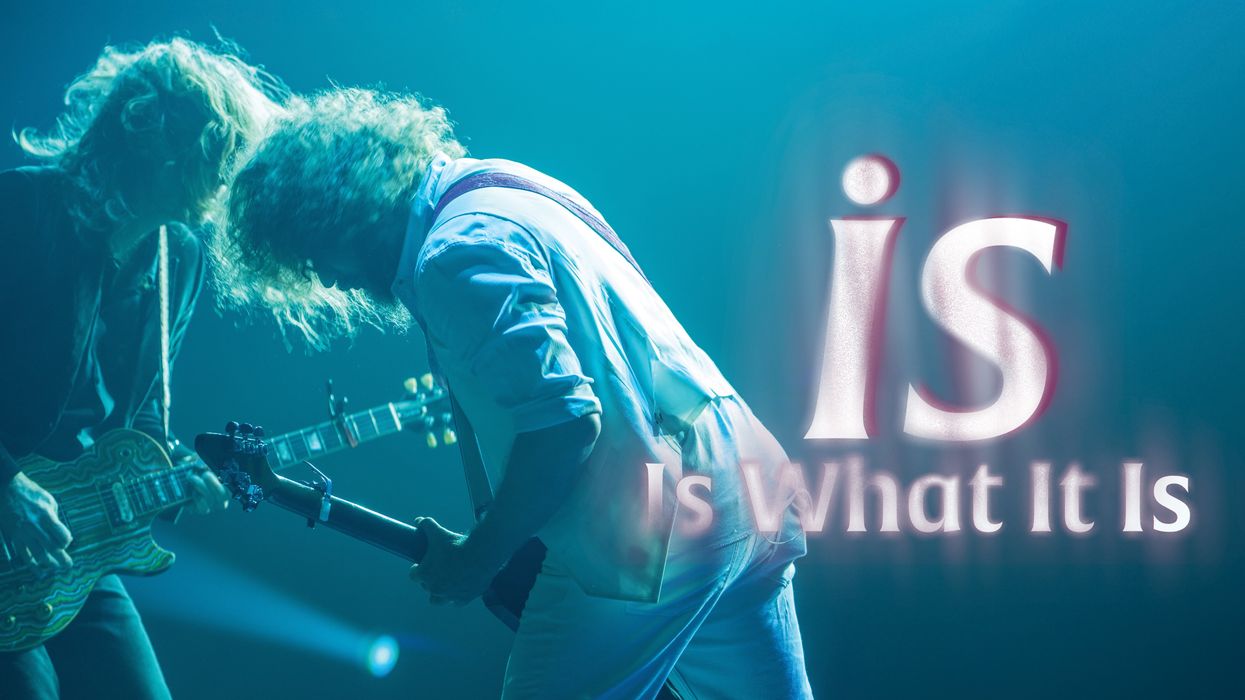“Time is such a fun thing to think about, how elastic it is and how strange it is,” muses My Morning Jacket singer and guitarist Jim James. For a band that’s weathered more than a quarter-century together, that elasticity and strangeness feel particularly poignant. After a period of uncertainty and creative fatigue that left fans, and the members themselves, questioning the group’s future, My Morning Jacket has over the past several years emerged reinvigorated.
Their latest album, Is, represents not just a continuation of the rebirth that began with 2021’s self-titled effort, but a profound evolution in their creative process: Currently, MMJ—which also includes guitarist Carl Broemel, bassist Tom Blankenship, keyboardist Bo Koster, and drummer Patrick Hallahan—find themselves in the midst of what Broemel characterizes as a “special and interesting era,” one marked by newfound inner peace, a willingness to relinquish control, and, as James simply puts it, “the freedom to do whatever the fuck we want,” that has resulted in some of their most focused and dynamic work to date.
Is emerges as the product of this revitalized My Morning Jacket, distilled from a wealth of material that James had accumulated, throwing “every single idea into the pot,” he says, rather than reserving some for solo projects as he’d done in the past. The result is both concentrated and adventurous, a tightly focused 10-song collection that still, in characteristic MMJ fashion, roams freely across stylistic boundaries. From the soaring leadoff track “Out in the Open,” a sort of rootsy take on U2’s widescreen anthem rock, to the evocative and soulful first single “Time Waited,” the heavy-riffing “Squid Ink” to the hypnotic psych-folk workout “Beginning From the Ending,” the lilting, harmony-laden pop nugget “I Can Hear Your Love” to the ominous minor-key prowl “River Road,” the album covers vast musical territory. “Jim has a giant archive of song ideas and it’s always growing,” Broemel says, and then laughs. “I think it’s the good and the bad thing about having a digital recording device in your hand at all times—you can capture every idea. So we had so much to work through.”
SoundStream
But Is also marks something of a letting go for James, who, for the first time in years, welcomed an outside producer into the fold. And not just any producer, but capital-P producer Brendan O’Brien, whose extensive resume spans music’s biggest names, from Pearl Jam, Stone Temple Pilots, and Rage Against the Machine to Bruce Springsteen, Neil Young, and AC/DC. For James, who had long acted as the band’s producer in an effort to “play all the positions myself,” this surrender of control was unusual. As for why they went with O’Brien, James says, “The thing that really struck me about Brendan was once I started playing him demos, he immediately had ideas and opinions that were really constructive without making it about his ego. He’s really great about telling you, ‘Ah, I don’t think this song’s as good as the rest.’ Or, ‘I don’t really like this chorus, what if we replaced it with something else?’ He was just always about the song.”
Adds Broemel, “He managed to pull us out of us, if that makes sense.”
“I think it’s the good and the bad thing about having a digital recording device in your hand at all times—you can capture every idea.” - Carl Broemel
To be sure, many of these songs both took shape and transformed in the studio. “I Can Hear Your Love” and “Beginning From the Ending,” for example, evolved from solo recordings with drum programming and sound effects into fuller band arrangements. But perhaps the most dramatic metamorphosis was “Out in the Open.” The song originated during the pandemic as a ukulele riff that James found so complex he “couldn’t even play it,” and that he eventually arranged into what he calls “kind of a ballad.” It sat for a couple years before he brought it to the band during these sessions. “When we listened to it, everybody had the same feeling as I did: ‘We like the riff, but where does it go? What does it do?’” James recalls. O’Brien provided the breakthrough. “He said, ‘What if we turn this into a rock song? Bring in the electric guitar, amp it up, and keep it getting bigger?’” The final version blends James’ original ukulele recording with a full-band, big-rock arrangement—what he describes as “a really cool merging of the unknown inspired by Brendan.”
Jim James' Gear

In addition to his Flying V, Jim James’ Gibson arsenal includes three ES-335s, an ES-355 prototype, a vintage Gibson Barney Kessel, a modded 1962 Reissue Les Paul Custom (pre-SG), and a Hummingbird.
Photo by Nick Langlois
Guitars
- Gibson ES-335 (black)
- Gibson ES-335 (sunburst)
- Epiphone Jim James ES-335
- Gibson ES-355 prototype
- Fender Custom Shop Tele
- Fender Custom Shop Strat
- Reuben Cox Custom Plywood T-Style
- Gibson Barney Kessel (vintage)
- Gretsch Country Gentleman (vintage)
- Modified Gibson 1962 Reissue Les Paul Custom (pre-SG)
- Gibson Flying V
- Gibson Hummingbird
- Gibson J-45
Amps
- 3 Monkeys Orangutan
- 3 Monkeys cab
- Rivera Silent Sister isolation cabinet with Mesa/Boogie Celestion speaker
Effects
- Devi Ever US Fuzz Monster
- MXR MC406 CAE Buffer
- ISP Deci-Mate G Decimator
- Boss BD-2W Waza Craft Blues Driver
- Boss OC-2
- Electro-Harmonix MEL9
- Malekko Spring Chicken
- EarthQuaker Devices Ghost Echo
- EarthQuaker Devices Spatial Delivery V2
- Universal Audio Golden Reverberator
- Universal Audio Astra Modulation Machine
- Universal Audio Starlight Echo Station
- Spaceman Orion
- SoloDallas The Schaffer Boost
- Radial SGI-44
- Strymon blueSky
- Boss DD-7 Digital Delay
- Strymon Zuma
- Strymon Ojai
- D’Addario CT-20 Tuner
Strings & Picks
- D’Addario Pure Nickel (.009–.045)
- D’Addario Phosphor Bronze Acoustic Extra Light (.010–.047)
- Dunlop Tortex .73 mm
This anything-goes mindset extended to the band’s approach to guitars and amplification. While James and Broemel brought their recent arsenal—including James’ Fender Princeton amp, his Gibson ES-335 signature model, a Gibson ES-355 prototype “that Gibson made me when we were first figuring out my guitar that I use a lot in the studio,” and his custom Reuben Cox plywood T-style guitar, alongside Broemel’s treasured 1988 Bigsby-equipped Les Paul Standard and Duesenberg Starplayer TV—O’Brien’s studio offered what Broemel describes as “a disgusting amount of amazing guitars.” The amp selection was equally impressive, running the gamut of Fender classics (“the brown amps, the black amps, the silver amps,” as Broemel puts it) along with discoveries like a Port City head that became a frequent go-to. Rather than being fussy about gear choices, the band found themselves drawn to whatever served the song best. “Half the time I wound up with one of Brendan’s SGs in my hand through one of Brendan’s amps,” James recalls. “I used to be more precious about it, but now I really just don’t give a shit at all, as long as it sounds right with the song.” This approach yielded particularly dramatic results on “Die For It,” where Broemel created a massive guitar solo by positioning two amps—“a Super Reverb and something else,” he says—in the middle of the room, capturing what he calls a “giant stereo thing that’s so wide and washed-out and crazy, kind of like what it feels like at our shows.”
“Half the time I wound up with one of Brendan’s SGs in my hand through one of Brendan’s amps.” - Jim James
It’s this sort of liberation from old habits that has helped recharge the band after almost three decades together. Although, James admits, “It ebbs and flows. There’s been periods where it’s been very easy and periods where it’s been very difficult.” Is reflects this hard-won wisdom; its title speaks to the fact that the music “just is what it is,” James says. “The record always makes itself. You really have to let go.”
Carl Broemel's Gear

Carl Broemel’s favorite 6-string is his 1988 Bigsby-equipped Les Paul Standard, which he puts to the test here during a Savannah, Georgia, concert.
Photo by Chris Mollere
Guitars
- 1988 Gibson Les Paul Standard with Bigsby
- Duesenberg Starplayer TV
- Duesenberg Caribou
- Creston Custom
Amps
- Carr Slant 6V head
- Emperor 4x12 cab with Warehouse speakers
- Rivera Silent Sister isolation cabinet with Warehouse speaker
Effects
- Hologram Electronics Chroma Console
- Electro-Harmonix POG
- Kingsley Harlot V3 Tube Overdrive
- JAM Pedals Delay Llama Xtreme
- Origin Effects SlideRIG Compact Deluxe MkII Compressor
- Eventide H9
- Boss TU-2
- Strymon Zuma
- GigRig G3 Switching System
Strings & Picks
- D’Addario EXL140 (.010–.052)
- Dunlop Tortex .73 mm
It’s a perspective that has enabled My Morning Jacket to find a path forward. As Broemel notes, “In some ways, all we want to be is like a brand-new band again, but that’s impossible. So we’ve just gotta keep going.” One thing that never changes, he adds, “is that the feeling of playing a good show never gets old. It’s like catching a huge fish. That’s evergreen for me.”
James agrees, noting that the band has never sounded better. “Music’s infinite,” he says. “We’ll never exhaust all the possibilities. As long as you’re trying something new, that’s what keeps it fun and fresh, hopefully for us and for the listener.”
YouTube It
Broemel, with his Creston Custom, and James, with a Fender Strat (and purple heart-shaped sunglasses), lead My Morning Jacket through the heavy riffs, deep grooves, and big unison bends of “Squid Ink” on Jimmy Kimmel Live!























![Rig Rundown: AFI [2025]](https://www.premierguitar.com/media-library/youtube.jpg?id=62064741&width=1245&height=700&quality=70&coordinates=0%2C0%2C0%2C0)












![Devon Eisenbarger [Katy Perry] Rig Rundown](https://www.premierguitar.com/media-library/youtube.jpg?id=61774583&width=1245&height=700&quality=70&coordinates=0%2C0%2C0%2C0)













